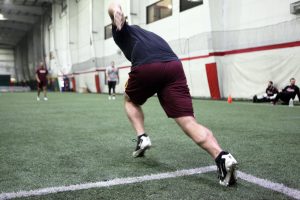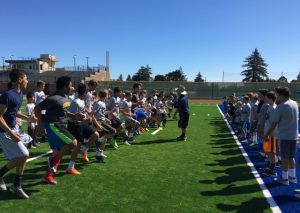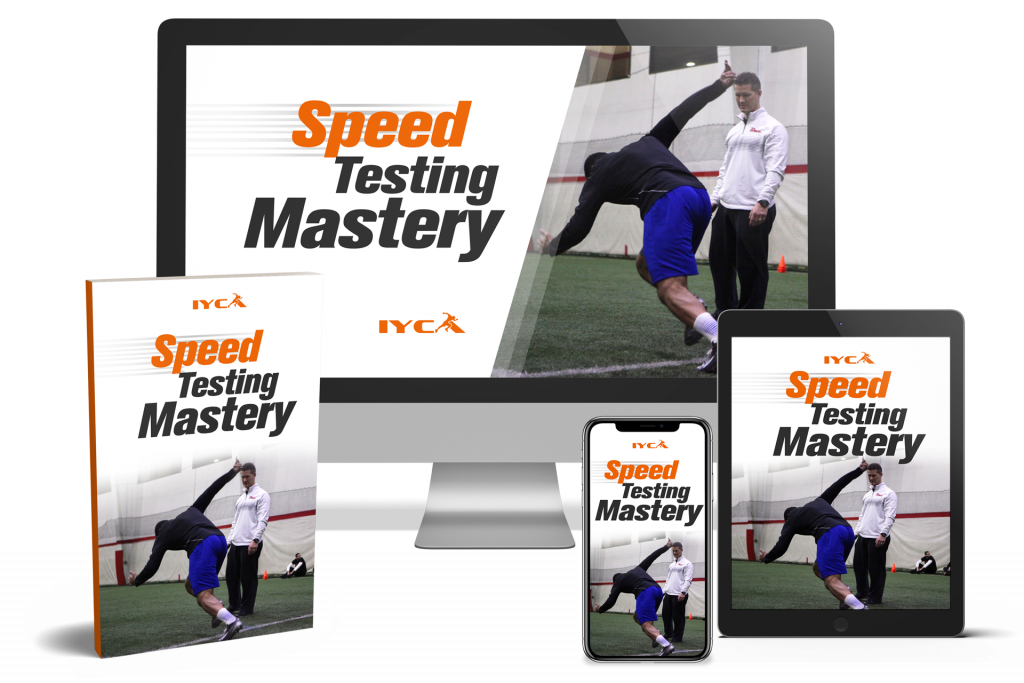Having quick, agile athletes is vital to most sports, so it should be a focus for every strength and conditioning program. We asked a roundtable of experts how they satisfy the need for speed in their training.
When thinking about speed and agility, many people picture the highlight-reel moments—an Olympic sprinter blazing through a 100-meter dash, a wide receiver breaking away down the sideline, or a baseball player stealing second. What do those three scenarios have in common? The athletes are running in a straight line. However, as strength coaches know, speed and agility training is not so straightforward.
Linear speed is undoubtedly important, but the ability to stop, start, and change direction is just as crucial, say the strength and conditioning coaches in our roundtable discussion (See “Our Panel” below). They don’t agree on everything, though. In fact, a few of them hold opposing views on the merit of equipment like ladders and dot mats.
Clearly, there is a lot to consider when putting together an effective speed and agility program for athletes. Here, five performance training experts give their varied takes.
OUR PANEL
Andre Bernardi, CSCS, USAW, PES, is the Head Strength and Conditioning Coach at North Greenville University. He is a certified specialist in speed and explosion through the National Association of Speed and Explosion and holds a sports conditioning specialty certification through the American Council of Exercise. Bernardi is also a certified specialist in sports nutrition through the International Sports Science Association.
Sean Edinger, MS, SCCC, USAW, is Assistant Athletics Director for Athletic Performance at Syracuse University, working specifically with the football team. He is responsible for conditioning players for new Head Football Coach Dino Babers’ up-tempo style of play. Prior to Syracuse, Edinger served as the Director of Strength and Conditioning at Bowling Green State University for two seasons.
Jeff Kipp, MS, CSCS, RSCC*D, is Head Strength and Conditioning Coach at Strake Jesuit College Preparatory in Houston. Before Strake Jesuit, he was an Assistant Strength and Conditioning Coach for the University of Kansas and spent 10 years as a Strength and Conditioning Coach at the United States Air Force Academy. He presents often on speed development at conferences and has authored many books for the NSCA about the topic.
Adam Linens, MS, CSCS, ATC, PES, CES, is an Assistant Strength and Conditioning Coach at the University of Oregon, working specifically with the men’s basketball team. Previously, he worked with the NBA’s Atlanta Hawks and Cleveland Cavaliers and the WNBA’s Atlanta Dream.
Josh Robertson, SCCC, is the Strength and Conditioning Coach at Conway (S.C.) High School. He was the Assistant Director of Speed, Strength, and Conditioning at Appalachian State University from 2006 to 2010 and served as Head Strength and Conditioning Coach at Wofford College from 2004 to 2006.
What’s your overall philosophy regarding speed and agility?
Jeff Kipp: Speed is important to almost every sport. For instance, I tell my soccer players, “How many balls are there on the field? Only one. So what’s everybody doing out there? They’re jostling for position, trying to get into an open spot on the field, or trying to stay with their man.” Being able to run fast and change directions efficiently is imperative to all of those activities.
When I’m putting together speed and agility programs, I incorporate exercises that will teach athletes how to load and control the body effectively, as well as generate force. However, I look at strength, speed, and agility equally, so I don’t focus all my effort on weightroom or acceleration work and then forget things like lateral movements. Programming this way makes for a balanced approach to all aspects of athletic performance.
Adam Linens: In my experience, all athletes want to do is go fast. But speed and agility training is not about how fast a player can accelerate, it’s about how fast they can stop and then reaccelerate multiple times. When NBA players get to the final years of their careers, they have no problems starting—they have problems stopping, landing, and changing direction. Those skills require the most eccentric strength, so I try to instill them early in my players’ careers.
That being said, much of what I teach is based on linear speed development. Although basketball athletes don’t need a ton of linear speed training—since they play a change-of-direction sport—good technique for linear speed will transfer to change-of-direction work and other movements.
Josh Robertson: When you focus on speed and agility, you get better athletes. Combine the correct weightlifting methods with the correct speed and agility rest periods and drill distances, and the result will be a great speed and agility training program.
Sean Edinger: First, there’s pure genetics—some kids are just fast. Then, there’s the ability to move efficiently and quickly stop, start, and change direction, which can level the playing field and raise up players who might not have as much God-given talent.
Andre Bernardi: We want our athletes to be able to put their feet on the ground and get from point A to point B faster than their opponents. Skill sets aside, if they do that enough times over the course of a game, they are likely to come out on top.
How do you improve speed and agility?
Edinger: Athletes, particularly when they first get on campus, need to get stronger in terms of horsepower. A lot of them have a limited amount of force they can produce, and I help them develop it in training.
The real trick when you’re talking about speed is getting athletes to engage their fast-twitch muscles: How quickly can they display force? To work on this, we do bounds, skips, box jumps, lateral jumps, and lateral movements and take-offs. We only do a few per set because I want maximum effort on each rep.
Spending too much time on plyometrics for speed work can be counterproductive, though. If you do plyometrics and athletes get tired, they’ll start spending a lot of time in contact with the ground, and you won’t get the benefits you want. A huge part of this is a lack of conditioning. If players are out of shape or think they’ll struggle to get through a workout, they’ll hold back.
As far as agility training, I don’t place a lot of stock in ladders, dot mats, and things of that nature because football players don’t use any of that footwork on the field. For example, remember when swing dancing was a big thing a few years ago? People looked like they could dance, but they just memorized the steps. It’s the same thing with ladder and dot drills. Athletes might look like they’re getting more agile, but they’re simply memorizing the footwork and executing it at a high rate of speed. There’s no momentum buildup, and they don’t have to stop and change direction.
Kipp: I have standard plyos that I use. I start with a snap-bound into base positions to teach athletes how to load the body. Then, I move into jumps where players drop into a position, hold it, and generate force. Over a longer period of time, such as an entire offseason, we’ll get into faster response exercises that incorporate the stretch-shortening cycle. This will include true plyometrics—multiple broad jumps, multiple squat jumps, and scissor jumps—that accentuate explosion.
Linens: I like to use ladders and hurdles to instill proper balance, body positioning, linear speed, and lateral quickness. We start with specific ladder drills to teach forward-to-backward change of direction, hip rotations, and pivoting. Then, I’ll get into more advanced drills with hurdles and cones. After that, we progress to reactionary training, where I use numbered cones, colored cones, or pointing in different directions to get athletes to react. During these sessions, I also like to use lateral resistors around their ankles to strengthen their hips.
Bernardi: We focus on the basics. We’ll warm up, and then we’ll do something I call “rapid response,” which is a quick-feet drill where players try to pick up and put down their feet as fast as possible. After that, I may do something like a mirror drill.
With agility, I’m pretty simple. I’m a big ladder and footwork guy. I stick to pro-agility drills, zigzag drills, and a lot of activities where athletes react off a partner. This really represents the demands of most sports because athletes constantly have to react quickly during competitions.
What role does technique have in speed and agility training?
Linens: Technique trumps everything. Some coaches overload athletes with repetitions or resistance when their movements aren’t correct to begin with. This only ingrains bad habits.
 Instead, I’ll teach a drill and make sure athletes have good technique before moving forward. After they’ve gotten proficient in the drill, we’ll add some resistance. However, I don’t add so much resistance that it makes the movement look sloppy. My general rule is: The more sport-specific a drill, the lighter the resistance.
Instead, I’ll teach a drill and make sure athletes have good technique before moving forward. After they’ve gotten proficient in the drill, we’ll add some resistance. However, I don’t add so much resistance that it makes the movement look sloppy. My general rule is: The more sport-specific a drill, the lighter the resistance.
Edinger: It’s important to remember that less is more. If you can only get 10 technically perfect reps out of a player, then 10 is what you’re looking for. Don’t make him try to do 15 or 20. When you’re talking about movement and speed in particular, never train a player after his form starts to falter. As soon as there’s a breakdown in technical proficiency, you need to stop—cut the drill, change the drill, or stop the session.
Bernardi: Teach technique work—foot placement, knee drive, and arm swing—before you do anything else. Once that’s accomplished, you can instruct athletes to put their feet into the ground and increase stride length or stride rate to maximize speed development.
To instill these movements, we’ll do a lot of quick shuffles where athletes claw the ground with their feet. From there, we may progress to a bound and then to a sprint, all the while emphasizing foot contact.
One of my favorite drills to stress technique is a march progression with a sled. Players start off like they’re doing a wall drill and switch to a slow march to emphasize their knee coming up and the ball of their foot driving to the ground. They do that a couple of times, and then it goes into a fast march. The drill ends with athletes pushing a sled, which really highlights the knee drive.
How do you make speed and agility training sport specific?
Kipp: I’ve always thought that you don’t train speed and agility for the sport—you train athletes to become faster, more agile performers at their sport. There are going to be times in every sport when an athlete is out of position and needs to react. If you didn’t train them to be versatile with their body positions and able to move through a full range of motion, it will affect how well they can react.
Edinger: I don’t subscribe to a sport-specific training mindset. Rather, I slant things to be like the sport I’m training. The drills that we use with Syracuse football are very specific to the sport and specific to what my coaches want players at each position to do. There are certain steps and movements for each position, and it’s important that the athletes practice them over and over until they become second nature.
For example, since wide receivers run routes where they push a defender, stop, come back, and run a hitch, we have them do a drill where they work on stopping in three steps. Throughout the action, their shoulders must be over their knees, and their knees must be over their toes. This way, they get the correct portion of their cleats into the ground and remain balanced. This drill is included in all their individual agility sessions.
Linens: I take the sport, break it down into different movements, and then teach corresponding pieces of it through a drill. I’m not teaching basketball skills, but our speed and agility training can focus on footwork related to an open step or crossover step that will help players drive to the basket or shuffle on defense.
Robertson: When I train an athlete on speed or agility, that is the training—not sport-specific speed and agility exercises.
What role does strength training play in your speed and agility work?
Kipp: It takes strength to slow the body, stop the body, and then reaccelerate in any given direction. So the stronger athletes are, the more easily they can stop themselves and create force against the ground to accelerate.
Linens: Strength training enhances speed and agility, and speed and agility enhance strength training. If you think of different concentric and explosive speed movements, they all require triple extension. We focus on triple extension in a lot of the exercises that we do, such as squat variations, dumbbell variations, kettlebell swings, arm dumbbell snatches, and clean variations.
To enhance change of direction, we emphasize single-leg exercises in the weightroom. I try to get athletes comfortable with balancing, exploding, controlling, and decelerating on one leg. Some of our exercises include variations of step-ups and lunges, single-leg Romanian dead lifts, and rear-foot elevator squats, as well as dumbbell split jerks.
Bernardi: Any opportunity I get in the weightroom to have athletes drive their knees and cycle their feet is going to make them faster. So I like doing speed squats and different lunge variations where athletes are focusing on their knee drive. We also do a lot of step-ups to develop speed.
Robertson: Going down below parallel in the back squat is the foundation of how we move. When athletes can lift more than their bodyweight in the back squat with speed in the movement, their speed and agility will go through the roof.
What advice would you give strength coaches who are starting to build their speed and agility programs?
Robertson: Don’t try to do too much. In America, we think you can take a zebra and run him in a thoroughbred race. We believe training will improve him or running him into the ground will change something mentally to enhance his performance. But this approach is detrimental because it attempts to do too much.
Some strength coaches have what I call “a box of hammers.” They pull out a small hammer and beat on the athlete and tear him down. When that doesn’t work, they get a bigger hammer. The next thing you know, the athlete is broken. They might say the athlete wasn’t good to begin with, but I’d say they didn’t train him right.
Kipp: Create a road map. Have a plan for where you’re going and how you’re going to get there, but understand there are going to be bumps along the way. Also, keep your eyes and ears open for new ideas. When it comes to speed and agility training, every coach out there can benefit from listening to their peers.
This article brought to you by our partnership with Training & Conditioning Magazine. For more great articles, visit their website.
Pete Croatto is a freelance writer based in Ithaca, N.Y. He can be reached at: pscroatto@gmail.com.
If you’re looking for more information on speed training, the IYCA recently released a new course called Speed Testing Mastery. This couse walks you through all the details of how to get athletes to run a faster 40- or 60-yard dash. The course includes 10 instructional video modules and a detailed 8-week training program. Also included is video analysis of 7 athletes that clearly show you exactly what to look for when coaching athletes. Learn more about Speed Testing Mastery.


